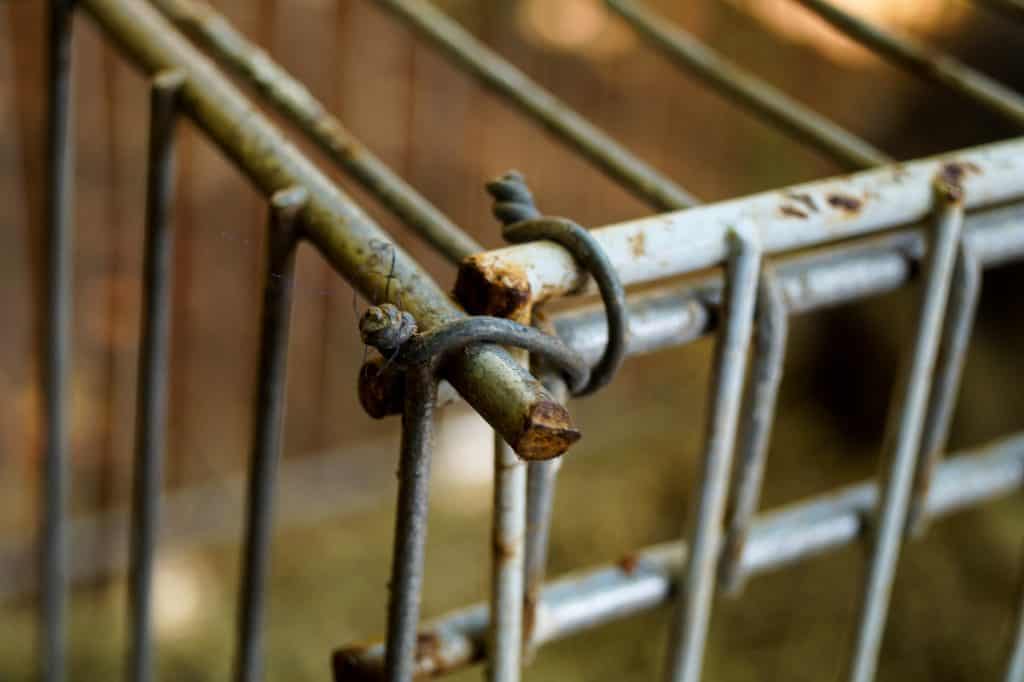
It is not uncommon that we see a lot of dogs locked in old and rusty cages. Some are also wearing metal collars tied to equally rusting chains.
Because of the tendency of dogs to lick and bite, there is always a high probability of rust being ingested by our favorite pets.
But it is not only old cages, collars, chains where dogs can lick, chew, and ingest rust from. Many dog lovers prefer feeding their dogs using iron bowls.
This makes it doubly possible that dogs may also be getting rusts from their eating or drinking bowls. But should it be a cause of alarm that our furry babies are ingesting rust?
Rust is generally safe for dogs. So never mind rushing to the vet when you noticed that your pup has taken in some rust. This is because rust is not bioavailable in dogs, meaning they are not readily absorbable. In other words, rust is not dangerous. Eating iron in one form or another is.
How Does Rust Form?
Not all metals can undergo rusting. It is only iron and steel among all other metals that rust. Rusting is a natural phenomenon that happens when iron is exposed to air and water.
When hydrogen and oxygen ions fuse with iron ions, iron oxide or rust develops. Keeping items made from steel and iron dry can delay the formation of rust.
While rust may not be harmful to dogs, it may not be good to see them locked and chained in dog cages, iron collars, and chains that are full of rust.
Rust may also have a bad smell and may also stain your pet. So if your dog gets in contact with a rusting material, you may not even want to cuddle it because of the smell and the rust can stain your clothes too.
You can easily clean rusts from cages, collars, chains, and bowls using white vinegar.
Why Is Iron Important in a Dog’s Body?
This particular mineral plays a very important role in a dog’s body. It helps transport oxygen throughout the body. It also aids in regulating the normal functioning of certain enzymes. If your pet does not have enough iron in its body, it may suffer from anemia, and you sure don’t want that.
What Is Iron Poisoning in Dogs?
It is important that a dog’s diet includes a fair amount of iron. Iron is essential in red blood cells and hemoglobin formation.
But when iron is taken in excessively, iron toxicity may ensue. The probability of a dog getting excessive iron from its meals may be very low.
Most possibly the dog may have foraged on unattended iron supplements, fertilizers, birth control pills, hand and foot warmers, oxygen absorber sachets, or heat patches.
In iron poisoning, there is an increase in free iron in the bloodstream. This is because, with an overdose, transferrin, which is the main carrying molecule of iron to the bone marrow, is saturated.
This means that much iron remains in the bloodstream and may enter the cells of the liver, heart, and brain where it can remove electrons from lipids in the cell membranes resulting in cellular damage.
Eating rust or iron oxide does not cause iron toxicity as it is not bioavailable, unlike the other iron ionic states which are ferrous and ferric.
These iron states are easily ionized, so they can increase iron in the body readily because they are readily absorbable.
In the case of rust, there may be no issues when ingested by a dog, even in large amounts. You have to remember that iron poisoning is different from eating rust.
What Are the Symptoms of Iron Poisoning?
When a dog is suspected of going through iron poisoning, it should be a cause of alarm as it can lead to death within 96 hours. Iron toxicity can be subdivided into four phases, each with its own manifestations.
• Stage 1. This stage occurs from 0 – 6 hours. Symptoms may be generally gastrointestinal issues like vomiting, diarrhea, abdominal pain and swelling, and loss of appetite. Seizure, rapid heart rate and lethargy can also be seen. In most cases, mild to moderate iron poisoning does not progress and dogs will recover pretty well.
• Stage 2: Occurring from 6 -24 hours. This is a latent period where there are no symptoms being manifested. It is in this stage wherein a dog can recover or may progress to stage 3 where more aggravated symptoms can be experienced.
• Stage 3: The worst clinical symptoms during this stage which occurs at 12 – 96 hours. Symptoms include hypotension, rapid heart rate, jaundice, muscle tremors, bloody diarrhea, seizures, shock, and organ failure. To avoid death, early treatment should be sought.
• Stage 4: During the 4th to 6th week, a dog with iron toxicity can suffer from jaundice, bloody diarrhea, intestinal blockages, and liver damage.
How Much Iron Is Toxic to Dogs?
Iron poisoning may depend on the overall health condition of a dog. For healthy dogs, less than 20 mg/kg of elemental iron may not be toxic. On the other hand, sickly dogs may find the same amount toxic.
Normally, ingestion of 20 – 60 mg/kg elemental iron may cause iron poisoning which can cause gastrointestinal issues. Above 60 mg/kg would mean more serious clinical symptoms.
When you suspect your dog to have taken larger amounts of iron, getting into the veterinarian’s clinic should be one of the first things to do where magnesium hydroxide or calcium carbonate shall be administered to reduce the iron absorption by 30 – 40%. Gastrointestinal decontamination will also be administered through induced vomiting.
Is Lawn Rust (Rust Fungus) Toxic to Dogs?
Lawn rust, also known as rust fungus, is a powdery substance with orange or rusty color that partially or completely coats a grass blade. If you have a lawn planted with Kentucky bluegrass or perennial ryegrass, your lawn can be infested with lawn rust more easily, especially if you have not fertilized your lawn with nitrogen for a long time. Lawn rust is fungal spores but is not harmful to either humans or pets, like your dog.
While rust fungus may not cause any health issues on your dog, it may be wiser to keep your dog out of the lawn infested by rust fungus. The spores may get stuck in your dog’s furs and may spread the infestation more easily to unaffected grasses.
Is Licking Rust Bad for Your Dog?
Iron and steel are two of the most common metals that are seen everywhere else. We have them in our gate, fence, and outdoor furniture. When they rust, expect your dog to go licking them. Licking and even ingesting a whole flake of rust is not harmful to dogs. The danger comes when the metal has some sharp-edged rust flakes which can wound a dog’s tongue, gums, and the digestive tract when not properly chewed. Rust is not bioavailable, so it cannot cause iron poisoning.
Why Do Dogs Lick on Non-Food Items?
We may look at licking dogs more normal than when they do not. We are used to seeing them licking on everything from stones to any new item they see. Of course, this includes our skin which can sometimes feel so sticky because of the unending licking from our fur baby.
But do you know that frequent licking of our dogs connote a clinical condition? It is an obsessive behavior that is known as pica. This condition is also seen in humans and it is characterized by uncontrollable cravings for the oddest things. Some studies show that it is related to mineral deficiency. Licking in dogs may also be a way of familiarizing with his new environment or new additions to his usual place.
Is Drinking Rust Water Bad for Dogs?
Just like licking or ingesting rust, drinking rust water is not bad for your dog’s health. But when water is rusty, you may suspect other contaminants in it. Bacteria and other harmful organisms thrive on dirty water, so it is safer to always check what our furry babies drink.
Why Is Stainless Steel the Best Material for a Dog Water Bowl?
Plastic, ceramic, and stainless steel are the most common materials used for dog water bowls. Stainless steel must be the most practical option as it is safe, durable, and easy to carry and clean. They also do not leach harmful chemicals. To choose the best stainless steel bowl, check for rubber coating at the bottom to stabilize the bowl and to prevent water from dripping to your floor.
How Can I Remove Rust from a Dog Cage?
Because dog cages are usually placed outdoors, they are prone to rust faster because of their exposure to the elements that speed up the oxidation process. The constant licking of dogs can also be a contributory factor. But don’t worry; rust can be easier to clean with white vinegar. The acetic acid in vinegar can dissolve the rust. Wet a hand towel with white vinegar and place it over the rusted parts. You can leave it for an hour or for heavily rusted parts, you can leave it for a day or two. Scrubbing the rust will be as easy as washing the dishes. Do this with other tools that are made from steel or iron.
Is Rust for Dogs?
So you should know by now that rust or iron oxide is not bad for your dog. What may be more dangerous are the bacteria and other harmful organisms that are embedded deep in the porous surfaces of rusting steel or iron. The sharp rust flakes can also leave wounds on your dog’s oral cavity and digestive tract.
To prevent your dog from ingesting excessive iron, taking precautionary measures can be the best way. Store iron supplements, birth control pills, fertilizers, heat patches, and other items that are bombarded with high amounts of iron from the reach of your dog. It is also necessary to watch your dog’s daily diet plan more closely, so that you are on track of your pet’s nutritional condition.





